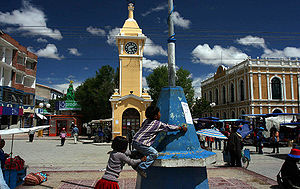
Uyuni
Encyclopedia

Bolivia
Bolivia officially known as Plurinational State of Bolivia , is a landlocked country in central South America. It is the poorest country in South America...
. It primarily serves as a gateway for tourists visiting the world's largest salt flats, the nearby Salar de Uyuni
Salar de Uyuni
Salar de Uyuni is the world's largest salt flat at . It is located in the Potosí and Oruro departments in southwest Bolivia, near the crest of the Andes, and is elevated above the mean sea level. The Salar was formed as a result of transformations between several prehistoric lakes...
.
Origin
Founded in 1890 as a trading post, the town has a population of 21,400 (2010 official estimate). The town has an extensive street-market. It lies at the edge of an extensive plain at an elevation of 3,670 meters above sea level, with more mountainous country to the east.There is little agriculture in the area because water supplies are scarce and somewhat saline. Today the town's primary function is as a gateway for tourists visiting the world's largest salt flats - the Salar de Uyuni
Salar de Uyuni
Salar de Uyuni is the world's largest salt flat at . It is located in the Potosí and Oruro departments in southwest Bolivia, near the crest of the Andes, and is elevated above the mean sea level. The Salar was formed as a result of transformations between several prehistoric lakes...
. Each year Uyuni receives approximately 60,000 visitors from around the globe. The city also acts as a gateway for commerce and traffic crossing into and out of Bolivia from and to Chile, and there is a customs and immigration post downtown.
Transport
It is an important transport hub, being the location of a major railway junction. Four lines join here, respectively from La PazLa Paz
Nuestra Señora de La Paz is the administrative capital of Bolivia, as well as the departmental capital of the La Paz Department, and the second largest city in the country after Santa Cruz de la Sierra...
(via Oruro), Calama
Calama, Chile
Calama is a city and commune in the Atacama Desert in northern Chile. It is the capital of El Loa Province, part of the Antofagasta Region. Calama is one of the driest cities in the world with average annual precipitation of just . The River Loa, Chile's longest, flows through the city...
(in Chile), Potosí
Potosí
Potosí is a city and the capital of the department of Potosí in Bolivia. It is one of the highest cities in the world by elevation at a nominal . and it was the location of the Spanish colonial mint, now the National Mint of Bolivia...
, and Villazón
Villazón
Villazón is a town in southern Bolivia, on the border with Argentina. It sits directly across a river from La Quiaca in Argentina. The town is a busy trading hub, with large quantities of goods flowing north....
(on the Argentine border, where the line now ends).
Of Uyuni the roads coconectan towards Oruro - La Paz, Sucre, Villazón (border with Argentina) and Ollagüe Chile.
Also there exists a tourist international airport of recent construction. At this point, two airlines service this airport: Amaszonas and TAM. Aerocon has announced that it will have flights to this destination starting August 2011.
Train cemetery
One of the major tourist attractions of the area is an antique train cemetery. It is located 3 km outside Uyuni and is connected to it by the old train tracks. The town served in the past as a distribution hub for the trains carrying minerals on their way to the Pacific OceanPacific Ocean
The Pacific Ocean is the largest of the Earth's oceanic divisions. It extends from the Arctic in the north to the Southern Ocean in the south, bounded by Asia and Australia in the west, and the Americas in the east.At 165.2 million square kilometres in area, this largest division of the World...
ports. The train lines were built by British engineers who arrived near the end of the 19th century and formed a sizable community in Uyuni. The engineers were invited by British-sponsored Antofagasta and Bolivia Railway Companies, which is now Ferrocarril de Antofagasta a Bolivia
Ferrocarril de Antofagasta a Bolivia
The Ferrocarril de Antofagasta a Bolivia is a private railway operating in the northern provinces of Chile. It is notable in that it was one of the earliest railways built to the gauge of , with a route that climbed from sea level to over , while handling goods traffic totaling near 2 million tons...
. The rail construction started in 1888 and ended in 1892. It was encouraged by the then Bolivian President Aniceto Arce
Aniceto Arce
Aniceto Arce Ruiz was President of Bolivia from 1888 until 1892. The Aniceto Arce Province is named after him. Arce was a native of Tarija but was educated as a lawyer and resided most of his life in Sucre, where he became one of the country's foremost silver-mining tycoons...
, who believed Bolivia would flourish with a good transport system, but it was also constantly sabotaged by the local Aymara indigenous Indians who saw it as an intrusion into their lives. The trains were mostly used by the mining companies. In the 1940s, the mining industry collapsed, partly due to the mineral depletion. Many trains were abandoned thereby producing the train cemetery. There are talks to build a museum out of the cemetery.

